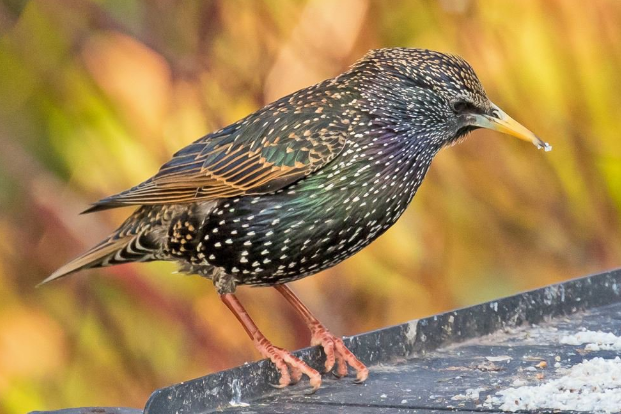Understanding Starling Nutrition: What Keeps These Birds Healthy?

Starlings, particularly the common starling (Sturnus vulgaris), are fascinating birds known for their striking plumage and dynamic social behaviors. As part of the family Sturnidae, these birds are found in various habitats across Europe, Asia, and North America. One of the key factors contributing to their success in diverse environments is their diet. In this article, we will delve into the nutritional needs of the starling bird, examining what keeps these avian wonders healthy and thriving.
The Importance of Nutrition for Starlings
Like all birds, starlings require a balanced diet to maintain their health, support their energetic lifestyles, and ensure reproductive success. Proper nutrition is vital for their growth, feather development, and overall vitality. Starlings are omnivorous, which means they eat various foods, allowing them to adapt to different environments and food availability.
What Do Starlings Eat?
Starlings consume a wide range of foods, which can be broadly categorized into three groups:
-
Insects and Invertebrates: Insects form a significant portion of the starling bird diet, particularly during the breeding season when protein is crucial for raising young. Common insects include beetles, ants, grasshoppers, and caterpillars. Invertebrates such as worms and slugs are also important, providing essential nutrients that support growth and development.
-
Fruits and Berries: Starlings are known for their fondness for fruits and berries, which they forage from trees, shrubs, and gardens. Some of their favorites include apples, cherries, blackberries, and elderberries. These foods provide energy through carbohydrates, vitamins, and minerals necessary for overall health.
-
Seeds and Grains: Starlings often feed on seeds and grains, particularly in agriculture. They may consume cereals, corn, and other seeds, which offer additional energy sources. These foods are especially important during winter when other food sources are scarce.
Seasonal Dietary Changes
The diet of the starling bird varies significantly throughout the year, influenced by food availability and seasonal changes. In spring and summer, when insects are abundant, starlings focus heavily on protein-rich foods to support their breeding efforts. As autumn approaches and insects become less plentiful, they shift their diet to fruits and seeds. When food scarcity is a concern in winter, starlings may form flocks to forage in agricultural fields or gardens, seeking out seeds and stored grains.
Nutritional Requirements
To maintain optimal health, starlings require a well-rounded diet that meets their nutritional needs. Key nutrients include:
-
Proteins: Essential for growth, feather development, and tissue repair, proteins are crucial for starlings, especially during breeding.
-
Carbohydrates: The primary energy source, carbohydrates are vital for maintaining high activity levels, particularly during foraging and flight.
-
Fats: Important for energy storage and insulation, fats help starlings survive colder temperatures.
-
Vitamins and Minerals: These are critical for various physiological functions, including immune response, bone health, and feather quality. Vitamins A, D, and E and minerals like calcium and phosphorus play significant roles in their overall health.
The Role of Foraging Behavior
Foraging behavior is critical in determining the nutritional intake of starlings. They are highly adaptable and can exploit different food sources based on availability. Observing starlings in urban and rural settings reveals their intelligence and resourcefulness in locating food. They may be seen foraging on the ground, rummaging through leaf litter, or even raiding bird feeders in gardens.
This adaptability not only ensures they can find food year-round but also allows them to thrive in various habitats, from cities to rural landscapes. In urban areas, starlings have learned to scavenge from human waste, showcasing their ability to adjust to changing environments.
Challenges to Starling Nutrition
Despite their adaptability, starlings face challenges that can impact their nutritional health. Pesticides used in agriculture can reduce the availability of insects, which are a primary protein source. Habitat loss due to urbanization and agricultural expansion also diminishes food availability.
Additionally, climate change can alter the timing of food availability, leading to mismatches between the birds' nutritional needs and the resources available. For instance, if insect populations decline earlier in the spring, starlings may struggle to find adequate food for their young.
Conclusion
In summary, understanding the nutrition of the starling bird is essential for appreciating these remarkable creatures and their ecological role. Their omnivorous diet, which includes insects, fruits, seeds, and grains, equips them to thrive in various environments. By adapting their foraging behavior to changing food availability, starlings continue to succeed in diverse habitats. However, habitat loss and pesticide use threaten their nutritional health. As we observe these birds in our gardens and parks, it’s important to remember their role as part of the ecosystem, particularly among the garden birds in the UK. Supporting their habitat through sustainable practices can help ensure that starlings continue to flourish in our environment.




